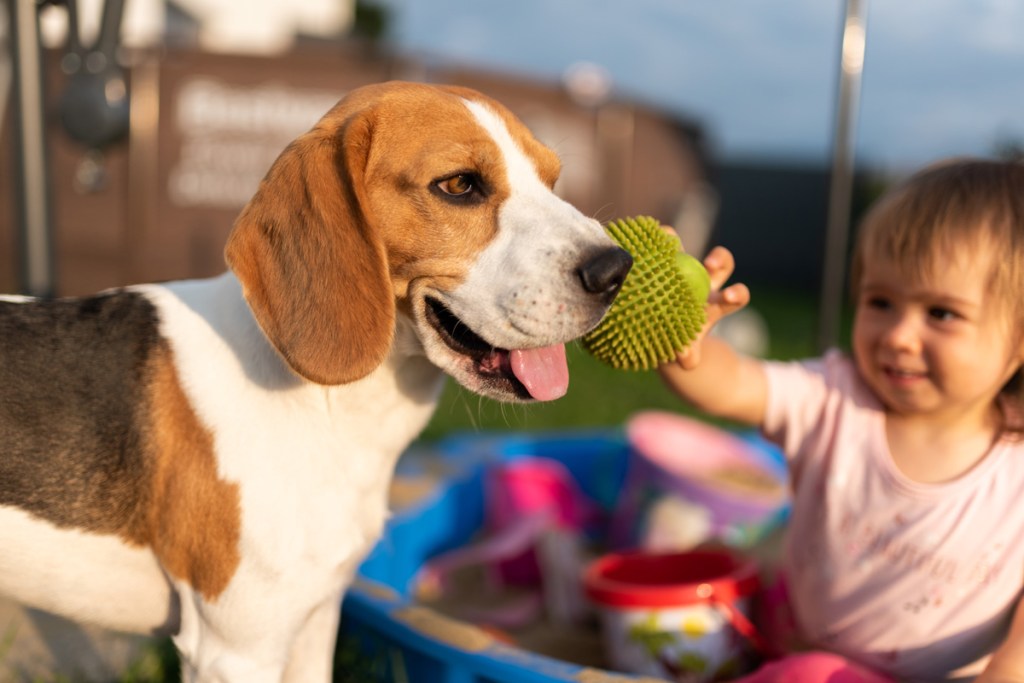Dogs make wonderful companions for children. They provide unconditional love and teach youngsters about responsibility and cooperation. When it comes to choosing a dog for the family, though, it’s important to pick a breed that’s tolerant of children. According to Petfinder.com, dogs who do best with kids have a gentle demeanor, friendly attitude, and trainable nature. When you live with an overactive toddler, it’s also important that the dog has enough stamina to match your child’s energy level. Training experts say that any interaction between young children and dogs should always be supervised. If you don’t have the time to watch them, then they should be separated until you do. Following are four of the best dog breeds for kids.

Golden retrievers
Spend any time browsing dog photos or videos online, and you’re sure to come across gentle goldens hanging out with the children in their families. You’ll see kids dressing them in clothes, hugging them, or lying against them to sleep. Goldens just love being with their people, whether big or small. This breed is smart, kind, loyal, and extremely patient, making them a great choice for a hyped-up kid. These dogs have lots of energy and will help your little one burn off steam by playing games of chase or fetch.
Coat maintenance: There is some maintenance involved in caring for a golden’s stunning coat. These dogs lose hair year-round but especially during shedding season, which happens in the spring and fall. Frequent brushing will help keep the shedding under control and avoid tangles and mats. According to the Golden Retriever Society, this breed should be bathed every six to eight weeks. However, more frequent bathing can help during the height of shedding season.
Labrador retrievers
There’s a reason this breed has held the number one spot on the American Kennel Club (AKC) Most Popular Dog Breeds list since 1991. Labradors are patient, gentle dogs, and with early socialization and training, they make wonderful companions for children. This breed has endless energy and loves to participate in family adventures. They are protective of family members and will enjoy nothing more than watching out for and playing with your energetic toddler. As people-pleasers, they are easy to train, which can be fun for kids.
Coat maintenance: This breed has a short double coat that’s easily maintained. They do shed a little throughout the year and a lot during the shedding season in the spring and fall. Brushing their coats at least once a week — and more during shedding season — will help manage the loose hair. For Labs who spend most of their time indoors, AKC experts recommend bathing every four to six weeks.
Beagles
Breed experts at the AKC describe beagles as “happy-go-lucky funny dogs with cute expressions” that children find so appealing. They are a playful, energetic, and sometimes mischievous breed, which of course, makes them a perfect companion for an active toddler. Being scent dogs, beagles love playing games like hide-and-seek, which also happens to be a favorite kids’ game. And when it’s time to take a break, these little hounds make great snuggling buddies.

Coat maintenance: Beagles have a short double coat that gets heavier in the winter. While they shed a little all year round, their main shedding season is in the spring. Grooming experts recommend weekly brushing to remove loose hair and promote new hair growth. Beagles need only occasional baths unless, of course, they roll in something stinky.
Cairn terriers
According to the Cairn Terrier Club of America (CTCA), this breed seems to have an “inborn affinity for children.” These little dogs seem to enjoy the high level of activity in a household with young kids. Breed experts at the CTCA say these dogs are physically tough and “forgive or overlook mishaps and stepped-on feet with characteristic generosity of spirit.” This is important as mistakes do happen, especially with toddlers. Cairns are highly intelligent and love learning but will lose interest if training sessions are boring. Teaching these terriers to perform ticks can be a fun activity for both your terrier and toddler.
Coat maintenance: Grooming experts at the AKC describe this breed as “easy keepers,” with weekly combing or brushing recommended. One bath every three months will work well for these terriers as bathing too often can strip the natural oils from his coat. A cairn’s coat will naturally grow long and shaggy. Long coats require more work, and many owners opt to have them stripped or clipped, a job best left to grooming professionals.
These are just some of the many dogs that get along well with kids. Whichever breed you choose, it’s essential to understand that even the most tolerant pet has his limits. Your toddler needs to learn how to be gentle and respect the dog’s boundaries. By teaching these rules at an early age, you will be helping your child and dog develop a loving and lasting relationship.



